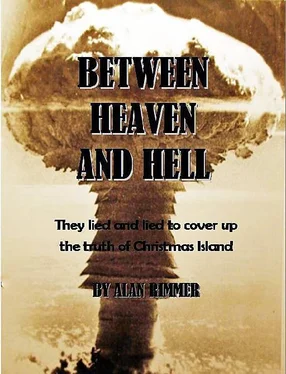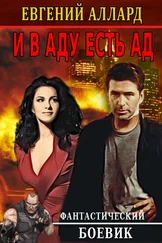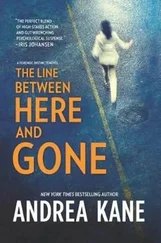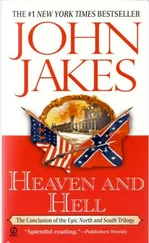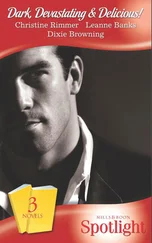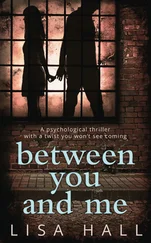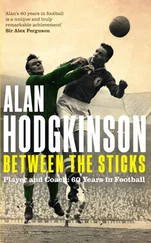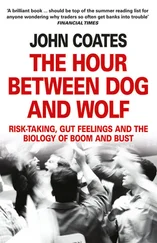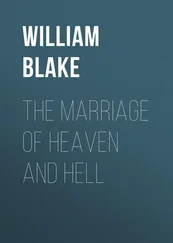But the other six, which includes Port London and the Joint Operations Centre, record measurable fallout, and some readings are way above proscribed safety limits.
This explosive document graphically illustrates the dishonesty and deceit as practised by the Ministry of Defence and its placemen.
For 50 years successive defence ministers have insisted absolutely that there was no radioactive fallout over Christmas Island after nuclear bomb tests. Yet here we have admissions, set out in official documents, that there was major contamination on Christmas Island following the Grapple Y explosion and others.
Two of the central pillars of the British government’s defence of its conduct over the nuclear weapons tests of the 1950s have been destroyed by the information contained in these documents. According to the evidence from the official archives this is what happened:-
Grapple Y, Britain’s biggest bomb, unleashed enormous elemental forces over an island already saturated with rain and enveloped by water vapour from earlier downpours. Christmas Island was like an enormous test-tube into which a giant spark was introduced.
The bomb created a violent rainstorm that scavenged highly radioactive fission products from the bomb which were borne by the wind over large areas of the island (as the scientists knew it would) and deposited over areas, like Port Camp, where most of the troops were gathered.
Huge hotspots of radiation formed at various points on the island as the fallout carried by the prevailing wind gradually came to earth. It was inevitable that the men were contaminated, either directly or by swallowing water, and swimming in the lagoons.
The contamination would have entered the bloodstream, eventually reaching vital organs producing various types of cancers. This internal exposure would not have shown up on the external monitors worn by the servicemen.
Exploding Grapple Y may have been a technical and scientific triumph, but it was also an exercise in folly that put at grave risk the lives and well-being of thousands of unsuspecting servicemen.
It was a gamble that has so far paid off for the government. For despite all the evidence there was still no actual proof that the servicemen so callously placed in danger were ever harmed by their experience. As we have seen, there is plenty of anecdotal evidence of the terrible effects the bomb had on the men who took part; many health surveys had been carried out by newspapers and other media organisations.
The only survey the government paid any credence to was that carried out by the National Radiological Protection Board which compared death rates with servicemen who took part in the bomb tests to those that didn’t. It concluded that the men were not harmed.
But this could simply not be so. Then it was realised the NRPB survey had one fatal flaw: it encompassed the 20,000 servicemen who attended all 21 tests carried out by the British in the 1950s. With so many bomb tests attended by so many men, statistics about health effects over so many years were bound to be blurred.
But now that just one bomb test had been identified as a rogue, the veterans could concentrate their efforts. They decided to compare the Grapple Y veterans with those from other bomb tests.
A total of 3,722 servicemen witnessed the Grapple Y blast. If a study of health problems in the men who attended this test found that higher than normal numbers had been hit by illness than men from the other tests, the important principal of cause (Grapple Y) and effect (higher incidents of sickness) could be established.
The National Radiological Protection Board had already set the precedent when it commissioned a small study by Leiden University into incidents of cataracts reported by nuclear veterans. The study, carried out in 1993 compared 10 veterans who suffered from cataracts with an equal number who didn’t. The study showed there was a small increase in the men who attended the bomb tests. This was kept secret.
The idea of targeting one bomb test was not new. American nuclear veterans had forced the Regan government into recognising their claims after a smart US attorney representing the family of a soldier who had died of leukaemia homed in one bomb test codenamed Smoky, conducted in the Nevada desert in August 1957.
He discovered that nine cases of leukaemia occurred among 3,224 men who participated in Smoky. This represented a significant increase over the expected incidence of 3.5 cases. The results were published, and the U.S. government was eventually forced to concede that the increase could have been due to radiation exposure.
There was an instant knock-on effect, and soon all 250,000 American nuclear veterans were included in a compensation scheme that recognised their claims if they conformed to certain medical criteria. If a pattern of ill health could be found in the Grapple Y veterans, the British government would be obliged to follow a similar path.
The veterans set about tracking down as many published accounts provided by nuclear test veterans over the years, to establish which bomb tests these individuals had attended. The beauty of this approach was it couldn’t be dismissed as biased because the men who complained had no idea of the significance of Grapple Y when they told their stories.
As far as they were concerned they were just “atomic veterans” and which explosion they witnessed was irrelevant.
To test the hypothesis, the veterans made a study of the research material carried out into birth defects in the grandchildren of nuclear veterans in 2002.
Although dismissed by the MoD, the importance of this study was that it provided vital information about the “when and where” of the tests the men witnessed. One of the first things they noted was that the majority of veterans who reported sickness in their grandchildren had been stationed on Christmas Island.
John Urquhart was asked to investigate further. He examined the data collected for the grandchildren study and discovered that indeed the majority of the complainants had been stationed on Christmas Island. But a by-product of his study stunned the veterans: 69 per cent of the Christmas Island cohort was present at Grapple Y.
This was a startling result. It was as if the grandchildren had suddenly reached out across the generations to tap their veteran grandfathers on the shoulder.
But was this just a bizarre coincidence, an aberration? Or was it proof of the pernicious nature of Grapple Y? Urquhart erred on the side of caution. He believed the survey was too small to give a definitive answer and said the only way to get a credible picture was to examine the records of all the nuclear veterans who had complained of health problems, and then establish what bomb tests they witnessed.
This was a difficult undertaking because by this time the official records of the BNTVA had been widely dispersed, and much of the material had been lost.
Fortunately, however, McGinley had retained a meticulous record of every nuclear veteran who had contacted him during his tenure as chairman of the BNTVA. These hand-written accounts, in five A4-sized journals, included details of more than 3,000 individuals, roughly a sixth of the total number of men who had attended the bomb tests.
And, crucially, the archive contained information enabling researchers to pin-point the location of the men and the bomb test(s) they were present at.
John Urquhart carried out a detailed analysis of the data contained in the “Y-files” and, together with information from published materials in newspapers and journals, produced a “master list” of 2,409 nuclear veterans who could be positively placed at one or more of the 21 nuclear bomb tests carried out by Britain in the 1950s.
The results were staggering: the response rate for men attending Grapple Y was 1,159 out of 3,722 men at Grapple Y, compared with 1,250 of the 13,206 men who attended all the other tests.
Читать дальше
